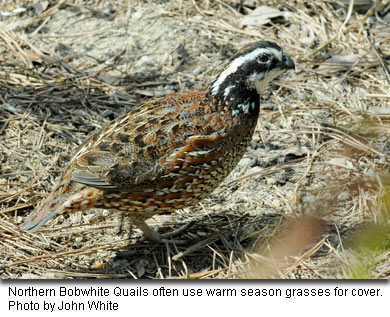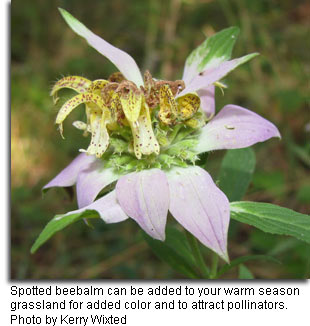In Maryland and many other surrounding states, grassland habitat has steadily declined. With this loss of habitat, many species which depend on grasslands for food, cover and breeding areas have also declined. Studies have shown that both upland game birds and songbirds prefer nesting in stands of warm season grasses rather than typical orchard grass/alfalfa fields. The conversion of as little as five percent of hayfields to warm season grasses can increase bird populations ten fold.
In addition to wildlife benefits, warm season grasses have been found to be more palatable to livestock while also producing higher weight gains than cool season grasses. So, if you have the space and the time, then consider planting warm season grasses for wildlife.
What are Warm Season Grasses?
Warm season grasses are grasses that grow best during the summer (June-August) and form large clumps. These grasses provide excellent wildlife habitat in addition to erosion control. Warm season grasses typically are tall plants that have large root systems that keep soil in place. Many warm season grasses are colorful and have large seed heads which provide food for a variety of species. Maryland has several native varieties of warm season grasses which are listed in the table below.
| Name | Height | Soil/Light Requirements |
|---|
Big bluestem
(Andropogon gerardii) | 5-7 ft | Tolerates dry sites with acidic, sandy, loamy or clayey soils; requires full sun |
Eastern gammagrass
(Tripsacum dactyloides) | 6-8 ft | Tolerates moist, well-drained soils; prefers fertile sites |
Little bluestem
(Schizachyrium scoparium) | 2-4 ft | Tolerates dry sites with acidic, sandy, loamy or clayey soils; requires full sun |
Indiangrass
(Sorghastrum nutans) | 4-6 ft | Tolerates dry-moderately wet sites; requires full sun |
Switchgrass
(Panicum virgatum) | 4-6 ft | Tolerates dry-wet sites with acidic, sandy, loamy or clayey soils; requires full to partial sun |
Wildlife Attracted to Warm Season Grasses
 Many species of wildlife are attracted to warm season grasses. Upland game birds like Bobwhite Quail use warm season grasses for cover while Wild Turkeys often nest and rear broods in dense grasses. Songbirds such as Field Sparrows, Indigo Buntings, Prairie Warblers, Eastern Meadowlarks, Loggerhead Shrikes and Grasshopper Sparrows use warm season grasses for cover while raptors like American Kestrels and Northern Harriers use the areas as hunting grounds. The raptors are often attracted to the cottontail rabbits, voles and field mice which make their homes in the grasses.
Many species of wildlife are attracted to warm season grasses. Upland game birds like Bobwhite Quail use warm season grasses for cover while Wild Turkeys often nest and rear broods in dense grasses. Songbirds such as Field Sparrows, Indigo Buntings, Prairie Warblers, Eastern Meadowlarks, Loggerhead Shrikes and Grasshopper Sparrows use warm season grasses for cover while raptors like American Kestrels and Northern Harriers use the areas as hunting grounds. The raptors are often attracted to the cottontail rabbits, voles and field mice which make their homes in the grasses.
What to Plant
Warm season grasses by themselves are excellent additions to your habitat. However, by including legumes and wildflowers with your warm season mixes, you are providing more diverse foods which attract more diverse wildlife. The recommended planting rate of flowers and legumes is from ¼ to 1lb of seeds per acre. When ordering seed, be sure to ask for "Pure Live Seed" (PLS). PLS is the percentage of live (viable) seed found in a bulk seed bag. A bag of bulk seed should be at least 75 percent PLS for good meadow establishment. The remaining percentage of the bulk seed bag contains plant parts.
For mixes with warm-season grasses, the Department of Natural Resource recommends the following seeding rate/acre in pounds of pure live seed:
-
Upland/Dry Soils-Grasses: 3 lbs. Indiangrass, 2 lbs. Big bluestem, 1 lb. Little bluestem with your choice of legumes and flowers.
-
Lowland/Moist Soils-Grasses: 3 lbs Big bluestem, 2 lbs. Indiangrass, 1 lb. Switchgrass with your choice of legumes and flowers.
| Bee balm |
(Monarda didyma) | W |
| Black-eyed susan |
(Rudbeckia hirta) | W |
| Blazingstar |
(Liatris spicata) | W |
| Common milkweed |
(Asclepias syriaca) | W |
| Butterflyweed |
(Asclepias tuberosa) | W |
| Evening primrose |
(Oenothera biennis) | W |
| Lance-leaved coreopsis |
(Coreopsis lanceolata) | W |
| Lupine |
(Lupinus perennis) | L |
| New England aster |
(Aster novae-angliae) | W |
| New York ironweed |
(Vernonia noveboracensis) | W |
| Partridge pea |
(Chamaecrista fasciculata) | L |
| Purple coneflower |
(Echinacea purpurea) | W |
| Roundhead bush clover |
(Lespedeza capitata) | L |
| Showy tick-trefoil |
(Desmodium canadense) | L |
| Spotted beebalm |
(Monarda punctata) | W |
| Sunflowers |
(Helianthus annuus) | W |
| Wild bergamont |
(Monarda fistulosa) | W |
| Wild senna |
(Senna hebecarpa) | L |
How to Establish Warm Season Grasses
 Once you have selected your seed mix, the next step is to establish the site. Establishing grasslands with warm season grasses requires time and planning. The best sites to plant warm season grasses include old cornfields with little weed cover. You can plant directly in these fields with no-till drills, unless the leftover corn stalks cover the entire field surface.
Once you have selected your seed mix, the next step is to establish the site. Establishing grasslands with warm season grasses requires time and planning. The best sites to plant warm season grasses include old cornfields with little weed cover. You can plant directly in these fields with no-till drills, unless the leftover corn stalks cover the entire field surface.
If the site is covered with sod or is an old pasture or fallow field, then you will have to remove the existing vegetation and control weeds during the initial establishment of warm season grasses.
Depending on the size of the area, you can either physically remove plants or kill them. If using herbicides, then select ones which do not persist in the soil and do not target seeds like glyphosate-based herbicides.
Close mowing two weeks prior to spraying is recommended to stimulate weed growth. Be sure to comply with herbicide application laws and avoid applying herbicides on wet plants or just before a rainstorm. Dead plant material should be removed a week after herbicide application.
Once the site is clear, you are ready to plant! Because most warm season grasses tolerate poor, acidic soils, there is no need to add soil amendments like lime or fertilizers. Warm season grasses just need open areas to establish. Spring seeding from March to May, when soil temperatures are at least 55 degrees or warmer, is the best way to establish warm season grasses, though seeds can also be planted over the winter, between the first hard frost and the end of May. These grasses can be planted using a no-till drill.
Conventional tilling can also be used, but the seedbed should be firmed both before and after seeding to make this method successful. Broadcast seeding can be used on small areas in conjunction with firming the soil. Be mindful that some seeds, like those from bluestems, are fluffy and require no-till drills with seed boxes designed to hold such seeds.
During the first few years, you may have to mow the site to 6-10 inches in height to allow the warm season grasses to establish. Once the warm season grasses are established, then you will not need to mow as often. As warm season grasses mature, the stands may become thick. Mowing in the fall every 4-7 years can help control some of the excessive growth. Some grasses can also be used for grazing.
For Additional Information, Contact:
Maryland Department of Natural Resources
Wildlife and Heritage Service
Tawes State Office Building, E-1
Annapolis MD 21401
410-260-8540
Toll-free in Maryland: 1-877-620-8DNR
[email protected]
Acknowledgements:
- Switchgrass Illustration by Kim Kraeer and Lucy Van Essen-Fishman, IAN Image Library (ian.umces.edu/imagelibrary/)
- Northern Bobwhite Quail by John White
- Spotted beebalm by Kerry Wixted